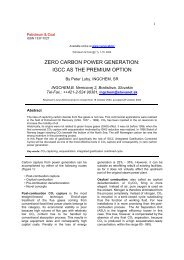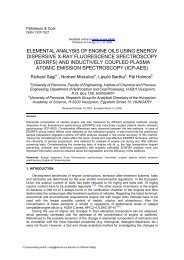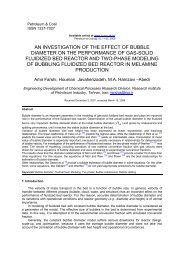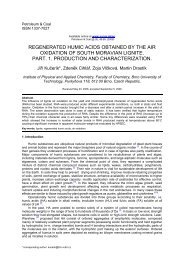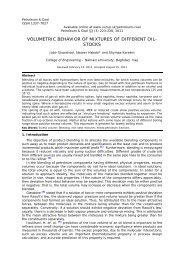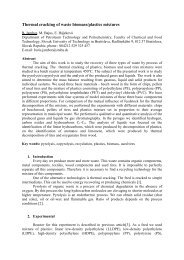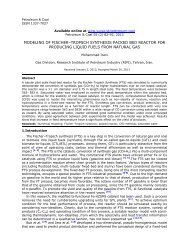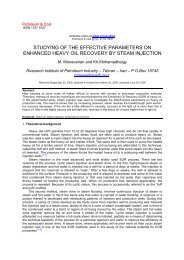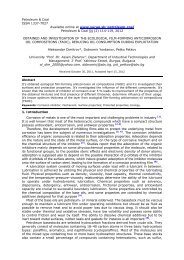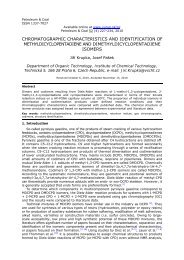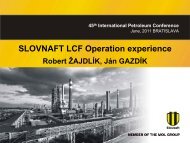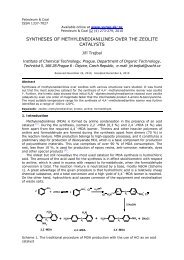prediction of nigerian crude oil viscosity using artificial neural network
prediction of nigerian crude oil viscosity using artificial neural network
prediction of nigerian crude oil viscosity using artificial neural network
Create successful ePaper yourself
Turn your PDF publications into a flip-book with our unique Google optimized e-Paper software.
184<br />
From equation (4), taking a derivative <strong>of</strong> O pk with respect to<br />
∂O<br />
∂I<br />
pk<br />
pk<br />
I<br />
pk<br />
, we have:<br />
= f I ) , (12)<br />
( pk<br />
Where the right- hand <strong>of</strong> the above equation is the transfer function <strong>of</strong> our <strong>neural</strong> <strong>network</strong>.<br />
Substituting Equations (8), (9), and (12) into equation (7), we obtain:<br />
Δ = η *(<br />
− ) * ( )<br />
(13)<br />
W d O f I * X<br />
ni<br />
pk<br />
pk<br />
pk<br />
pi<br />
Equation (8) gives the required weight change within a link between a node (i ) in layer J<br />
and a node (n) in the output layer k.<br />
η is usually denoted the learning rate that takes any value between 0 and 1.<br />
A popular modification to increase the learning rate <strong>of</strong> the back propagation algorithm is the<br />
use <strong>of</strong> a momentum term as reported by Al - Kaabi et al. [18] . Hence, the change in the link<br />
or weight with the momentum term can be defined and added as follows:<br />
ΔW ni (n+1) =η* δ<br />
pk<br />
* f ( I<br />
pk<br />
) * X<br />
pi<br />
+α*ΔW ni (n) (14)<br />
Where α takes values between 0 and 1.<br />
Also, the weight change (∆W ij ) between the input layer (I) and hidden layer (J) can be<br />
derived as follows:<br />
The learning <strong>of</strong> the <strong>neural</strong> <strong>network</strong> is accomplished by changing the weight between the<br />
links by the following incremental value ∆W ij , which is defined as follows:<br />
∂E<br />
Δ Wij<br />
= −η *<br />
(15)<br />
∂W<br />
ij<br />
Applying the chain rule in the right- hand side <strong>of</strong> the equation (15), we have<br />
∂E<br />
∂E<br />
∂Opj<br />
∂net<br />
= * *<br />
(16)<br />
∂W<br />
∂O<br />
∂net<br />
∂W<br />
ij<br />
pj<br />
ij<br />
Taking the derivative <strong>of</strong> E with respect to O pj in Equation (5), after replacing the subscript k for j,<br />
we have<br />
∂E<br />
= ( d<br />
pj<br />
− Opj<br />
)<br />
(17)<br />
∂O<br />
pj<br />
Taking the derivative <strong>of</strong> O pj with respect to net or I pj in Equation (2), we have:<br />
∂Opj<br />
= f ( net)<br />
(18)<br />
∂net<br />
Taking a derivative <strong>of</strong> net or I pj with respect to W ij in Equation (1), we get:<br />
∂net<br />
∂∑ Wij * xpi<br />
= = Xpi<br />
(19)<br />
∂Wij<br />
∂Wij<br />
At the hidden layer (J), the local error is equal to the following:<br />
∂E<br />
δ<br />
pj<br />
= * f ( net)<br />
(20)<br />
∂O<br />
pj<br />
From Equations (16), (17), (18), (19), and (20) , we obtain the final results<br />
Δ W<br />
ij<br />
= η *δ<br />
pj<br />
* X<br />
pi<br />
(21)<br />
For the weight update <strong>using</strong> the gradient rule, we find;<br />
W ( n + 1) = W ( n)<br />
+η * δ * X<br />
(22)<br />
ij<br />
ij<br />
6. Data acquisition and analysis<br />
pj<br />
pi<br />
The 32 data sets used in this work were collected from the Niger delta region <strong>of</strong> Nigeria.<br />
The ranges <strong>of</strong> the data are the following: reservoir temperature (154 to 234 o F), <strong>oil</strong> gravity<br />
(19–45.4 o API), solution gas <strong>oil</strong> ratio(210–3100 SCF/BBL), gas gravity(0.690-1.118, air = 1.0),



